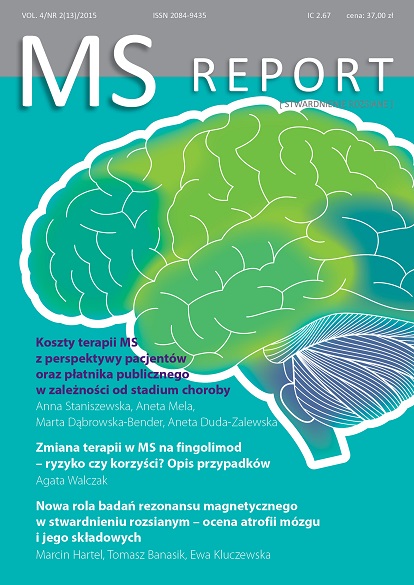Nowa rola badań rezonansu magnetycznego w stwardnieniu rozsianym – ocena atrofii mózgu i jego składowych Artykuł przeglądowy
##plugins.themes.bootstrap3.article.main##
Abstrakt
Niepoznany w pełni proces patologiczny w stwardnieniu rozsianym przez demielinizację i neurodegenerację prowadzi do atrofii mózgowia, stanowiącej dzisiaj najbardziej obiecujący wykładnik stanu klinicznego chorego. Rutynowe badanie metodą rezonansu magnetycznego służy wykrywaniu ognisk demielinizacyjnych i ocenie ich ewolucji. Ocena pozornie niezmienionych części ośrodkowego układu nerwowego pozostaje jednak poza możliwościami standardowych sekwencji. Techniki wolumetryczne pozwalają na wykrycie różnic w objętości mózgu i jego składowych, które mają wyraźny związek z objawami pacjentów. Niniejszy artykuł opisuje możliwości analizy objętościowej ze szczególnym uwzględnieniem podstruktur mózgowia.
##plugins.themes.bootstrap3.article.details##
Copyright © by Medical Education. All rights reserved.
Bibliografia
2. Geurts J.J., Calabrese M., Fisher E. et al.: Measurement and clinical effect of grey matter pathology in multiple sclerosis. Lancet Neurol. 2012; 11: 1082-1092.
3. Stadelmann C.: Multiple sclerosis as a neurodegenerative disease: pathology, mechanisms and therapeutic implications. Curr. Opin. Neurol. 2011; 24: 224-229.
4. Filippi M., Bozzali M., Rovaris M. et al.: Evidence for widespread axonal damage at the earliest clinical stage of multiple sclerosis. Brain 2003; 126: 433-437.
5. Simon J.H.: Brain atrophy in multiple sclerosis: what we know and would like to know. Mult. Scler. 2006; 12: 679-687.
6. Vigeveno R.M., Wiebenga O.T., Wattjes M.P. et al.: Shifting imaging targets in multiple sclerosis: from inflammation to neurodegeneration. J. Magn. Reson. Imaging. 2012; 36: 1-19.
7. Deloire M.S., Ruet A., Hamel D. et al.: MRI predictors of cognitive outcome in early multiple sclerosis. Neurology 2011; 76: 1161-1167.
8. Rocca M.A.: Deep grey matter: current and new technologies. Mult. Scler J. 2014; 20: 3-13.
9. Granberg T., Martola J., Bergendal G. et al.: Corpus callosum atrophy is associated with cognitive impairment in multiple sclerosis: results of a 17-year longitudinal study. Mult. Scler. 2014 Dec 5. pii: 1352458514560928.
10. Durand-Dubief F., Belaroussi B., Armspach J.P. et al.: Reliability of Longitudinal Brain Volume Loss Measurements between 2 Sites in Patients with Multiple Sclerosis: Comparison of 7 Quantification Techniques. AJNR Am. J. Neuroradiol. 2012; 33(10): 1918-1924.
11. Narayana P.A., Govindarajan K.A., Goel P. et al.: Regional cortical thickness in relapsing remitting multiple sclerosis: A multi-center study. NeuroImage Clin. 2012; 2: 120-131.
12. Desikan R.S., Ségonne F., Fischl B. et al.: An automated labeling system for subdividing the human cerebral cortex on MRI scans into gyral based regions of interest. NeuroImage 2006; 31(3): 968-980.
13. Fischl B., van der Kouwe A., Destrieux C. et al.: Automatically parcellating the human cerebral cortex. Cereb. Cortex. 2004; 14(1): 11-22.
14. Fischl B.: FreeSurfer. NeuroImage 2012; 62(2): 774-781.
15. Destrieux C., Fischl B., Dale A. et al.: Automatic parcellation of human cortical gyri and sulci using standard anatomical nomenclature. NeuroImage 2010; 53(1): 1-15.

